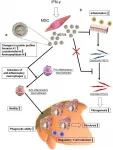Volunteer firefighters have higher levels of 'forever chemicals'
Levels of potentially health-threatening chemicals rise with years of service, Rutgers study finds
2021-05-03
(Press-News.org) Volunteer firefighters -- who comprise more than 65 percent of the U.S. fire service -- have higher levels of "forever chemicals," per- and polyfluoroalkyl substances (PFAS), in their bodies than the general public, according to a Rutgers study.
The study, which was published in the International Journal of Environmental Research and Public Health, compared the levels of nine PFAS chemicals in the blood of volunteer firefighters against levels in the general population.
It is the first study to evaluate volunteer firefighters' exposure to PFAS, which are chemicals that accumulate in human bodies and in the environment and are found in everyday items like electronics and carpeting. PFAS have been associated with numerous health conditions that impact firefighters, including cardiovascular disease. Increasing evidence has linked them to cancer.
"The primary cause of line-of duty death among firefighters are heart attacks. They also get and die from many types of cancer more often than other people," said lead author Judith Graber, an associate professor at Rutgers School of Public Health and a faculty member at the Environmental and Occupational Health Sciences Institute. "More than 95 percent of the U.S. population have these chemicals to some degree in their bodies, but firefighters have heightened exposure to PFAS through their protective gear and fire suppression foam and the burning materials they encounter that release particles, which can be inhaled or settle on gear and skin."
The study surveyed 135 members of a volunteer fire department in New Jersey on their lifestyle and cancer risk factors and compared traces of nine PFAS chemicals in their blood against the levels recorded in the general population in the Centers for Disease Control and Prevention's National Health and Nutrition Examination Survey, which tracks the health status of a nationally representative sample of 5,000 people annually. Although there are more than 4,000 PFAS chemicals, the study looked at the nine chemicals that the CDC has tracked the longest and are most often seen in the general population.
The researchers found that the levels of two of the chemicals studied -- perfluorododecanoic acid (PFDoA) and perfluorodecanoic acid (PFDA) -- were higher in volunteer firefighters. "Notably, we found PFDoA levels in 80 percent of the firefighters, but little in the general public," Graber said.
Higher chemical levels also were associated with the number of years of firefighting; the average participant had 20 years of experience. Since they are always on call, volunteer firefighters could potentially accumulate more years of firefighting-related exposures than their career counterparts, Graber said.
"The number one risk of a firefighter is being protected from the fire. The chemicals used in fire suppression foam and the protective clothing firefighters use came out 40 years ago when people thought they were safe, and they work well for what they are intended to do," Graber said. "Further research is needed to better understand the sources of these chemicals and to design effective foam and protective clothing that do not use these chemicals."
INFORMATION:
ELSE PRESS RELEASES FROM THIS DATE:
2021-05-02
Boston, MA (May 2, 2021) - A new study, presented today at the AATS 101st Annual Meeting, found that heart transplantation using donation after cardiac death (DCD) with normothermic regional perfusion (NRP) is feasible in the United States. Broader application of DCD heart transplantation has the potential to increase cardiac allograft availability by 20-30 percent. Over a one-year period, from January 2020 to January 2021, eight heart transplants were performed using cardiopulmonary bypass (CPB) for immediate regional reperfusion and cardiac unloading to accomplish optimal myocardial salvage. All hearts ...
2021-05-02
Boston, MA (May 2, 2021) - A new study, presented today at the AATS 101st Annual Meeting, finds that AATS Foundation fellowships support success in academic surgery career tracks. The AATS Foundation has two primary grant funding mechanisms: the AATS Foundation Scholarship and the Surgical Investigator Award. The study looked at publications, citations, NIH funding, and leadership position of awardees, among other factors.
Results show that recipients of both the AATS Surgical Investigator award and the Foundation Scholarship demonstrate sustained scholarship ...
2021-05-02
Boston, MA (May 2, 2021) - A new study, presented today at the AATS 101st Annual Meeting, shows an association between decreased survival at five years and leaving an atrial communication at biventricular repair of unbalanced AVSD after adjusting for other known risk factors. During repair of atrioventricular septal defect (AVSD), surgeons may leave an atrial level shunt when they have concerns about postoperative pulmonary hypertension, a hypoplastic right ventricle (RV), hypoplastic left ventricle (LV), or as part of their routine practice. The study sought to determine factors associated with mortality after biventricular repair of AVSD.
The study included 581 patients enrolled from 31 Congenital Heart Surgeons' ...
2021-05-02
Boston, MA (April 30, 2021) - A new study, presented today at the AATS 101st Annual Meeting, found that patients treated surgically for segmental Chronic Thromboembolic Pulmonary Hypertension (CTEPH) had excellent outcomes with the vast majority doing very well in the long term without any additional treatment other than surgery. In addition, the study found that the proportion of CTEPH patients with segmental disease increased dramatically during the study period - from 2005 to 2020. At the beginning of the study, roughly seven percent of patients were diagnosed with segmental disease. During the last five years of the study, the proportion ...
2021-05-01
Boston, MA (May 1, 2021) - A new study, presented today at the AATS 101st Annual Meeting, and simultaneously published in the Journal of the American College of Cardiology, finds that patients suffering from severe mitral regurgitation should be carefully screened and counselled before undergoing transcatheter edge-to-edge mitral repair (TEER). Data showed that up to 95 percent of patients who needed surgery after failed TEER could not have their valves repaired, and needed mitral valve replacement to resolve the issue. The findings highlight the need to select patients carefully ...
2021-05-01
Boston, MA (May 1, 2021) - Preliminary results of a clinical trial, presented today at the AATS 101st Annual Meeting, showed that a new, low-profile thoracic aortic endograft is safe and effective in the treatment of descending thoracic aortic aneurysm or penetrating atherosclerotic ulcer (PAU) diseases. A multi-disciplinary team, led by both cardiac and vascular surgeons as co-investigators, conducted the study in 36 centers in the United States and Japan, enrolling patients between 2016 and 2019.
The trial aimed to measure safety and efficacy of the RELAY®Pro endovascular device, a second-generation product featuring a dramatically reduced profile and a non-bare stent ...
2021-05-01
Boston, MA (May 1, 2021) - A new study presented today at the AATS 101st Annual Meeting, found that the percentage of patients undergoing esophagectomy for cancer who suffer Venous Thromboembolism (VTE) post-operatively is much higher than previously reported, with as many as 24 percent suffering from Deep Vein Thrombosis (DVT) or Pulmonary Embolism (PE). Six-month mortality for patients with VTE was 17.6 percent compared to 2.1 percent for those without.
Venous Thromboembolism (VTE) is a common, potentially preventable post-operative complication leading to significant morbidity and mortality. Esophagectomy patients are amongst the highest risk groups ...
2021-05-01
Niigata, Japan--Researchers from Niigata University , the University of Tokyo, Osaka University and Tokyo Medical University, Japan have developed a new approach that could revolutionize the treatment, prevention, and possibly reversal of the damages caused by liver diseases. This novel strategy exploits small extracellular vesicles (sEVs) derived from interferon-γ (IFN-γ) pre-conditioned MSCs (γ-sEVs).
Cirrhosis and other chronic liver diseases remain a global health concern, with close to 2 million deaths reported annually, these account for approximately 3.5% of annual worldwide deaths. All these ...
2021-05-01
Researchers from University of Arizona and University of Utah published a new paper in the Journal of Marketing that examines why most scholarly research is misinterpreted by the public or never escapes the ivory tower and suggests that such research gets lost in abstract, technical, and passive prose.
The study, forthcoming in the Journal of Marketing, is titled "Marketing Ideas: How to Write Research Articles that Readers Understand and Cite" and is authored by Nooshin L. Warren, Matthew Farmer, Tiany Gu, and Caleb Warren.
From developing vaccines to nudging people to eat less, scholars conduct research that could change the world, but most of their ideas either are misinterpreted by the public or never escape the ivory tower.
Why does most academic ...
2021-05-01
Supporting female survivors of childhood maltreatment is critical to disrupting intergenerational abuse as new research from the University of South Australia shows a clear link between parents who have suffered abuse and the likelihood of their children suffering the same fate.
The finding amplifies an acute need for far better support for victims of child maltreatment to ensure safer and more nurturing environments for all children.
Funded by the NHMRC and the Channel 7 Children's Research Foundation, and published in The Lancet Public Health today, the study found that most child maltreatment is occurring among families caught up in intergenerational cycles of child abuse and neglect - 83 per cent of ...
LAST 30 PRESS RELEASES:
[Press-News.org] Volunteer firefighters have higher levels of 'forever chemicals'
Levels of potentially health-threatening chemicals rise with years of service, Rutgers study finds

